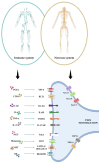Chronic Pain in Musculoskeletal Diseases: Do You Know Your Enemy?
- PMID: 35566735
- PMCID: PMC9101840
- DOI: 10.3390/jcm11092609
Chronic Pain in Musculoskeletal Diseases: Do You Know Your Enemy?
Abstract
Musculoskeletal pain is a condition that characterises several diseases and represents a constantly growing issue with enormous socio-economic burdens, highlighting the importance of developing treatment algorithms appropriate to the patient's needs and effective management strategies. Indeed, the algic condition must be assessed and treated independently of the underlying pathological process since it has an extremely negative impact on the emotional and psychic aspects of the individual, leading to isolation and depression. A full understanding of the pathophysiological mechanisms involved in nociceptive stimulation and central sensitization is an important step in improving approaches to musculoskeletal pain. In this context, the bidirectional relationship between immune cells and neurons involved in nociception could represent a key point in the understanding of these mechanisms. Therefore, we provide an updated overview of the magnitude of the musculoskeletal pain problem, in terms of prevalence and costs, and summarise the role of the most important molecular players involved in the development and maintenance of pain. Finally, based on the pathophysiological mechanisms, we propose a model, called the "musculoskeletal pain cycle", which could be a useful tool to counteract resignation to the algic condition and provide a starting point for developing a treatment algorithm for the patient with musculoskeletal pain.
Keywords: chronic pain; interdisciplinarity; musculoskeletal diseases; musculoskeletal pain; nociceptive stimulation; sensitization.
Conflict of interest statement
The authors declare no conflict of interest.
Figures




References
Publication types
LinkOut - more resources
Full Text Sources
Medical

